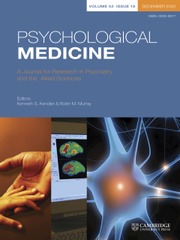Crossref Citations
This article has been cited by the following publications. This list is generated based on data provided by
Crossref.
Raes, An K.
De Raedt, Rudi
Verschuere, Bruno
and
De Houwer, Jan
2009.
Failure to loose fear: The impact of cognitive load and trait anxiety on extinction.
Behaviour Research and Therapy,
Vol. 47,
Issue. 12,
p.
1096.
Casey, B.J.
Glatt, C.E.
Tottenham, N.
Soliman, F.
Bath, K.
Amso, D.
Altemus, M.
Pattwell, S.
Jones, R.
Levita, L.
McEwen, B.
Magariños, A.M.
Gunnar, M.
Thomas, K.M.
Mezey, J.
Clark, A.G.
Hempstead, B.L.
and
Lee, F.S.
2009.
Brain-derived neurotrophic factor as a model system for examining gene by environment interactions across development.
Neuroscience,
Vol. 164,
Issue. 1,
p.
108.
Harro, Jaanus
2010.
Inter-individual differences in neurobiology as vulnerability factors for affective disorders: Implications for psychopharmacology.
Pharmacology & Therapeutics,
Vol. 125,
Issue. 3,
p.
402.
Shin, Lisa M
and
Liberzon, Israel
2010.
The Neurocircuitry of Fear, Stress, and Anxiety Disorders.
Neuropsychopharmacology,
Vol. 35,
Issue. 1,
p.
169.
Blackmon, Karen
Barr, William B.
Carlson, Chad
Devinsky, Orrin
DuBois, Jonathan
Pogash, Daniel
Quinn, Brian T.
Kuzniecky, Ruben
Halgren, Eric
and
Thesen, Thomas
2011.
Structural evidence for involvement of a left amygdala-orbitofrontal network in subclinical anxiety.
Psychiatry Research: Neuroimaging,
Vol. 194,
Issue. 3,
p.
296.
Shin, Lisa M.
and
Liberzon, Israel
2011.
The Neurocircuitry of Fear, Stress, and Anxiety Disorders.
Focus,
Vol. 9,
Issue. 3,
p.
311.
Kühn, Simone
Schubert, Florian
and
Gallinat, Jürgen
2011.
Structural correlates of trait anxiety: Reduced thickness in medial orbitofrontal cortex accompanied by volume increase in nucleus accumbens.
Journal of Affective Disorders,
Vol. 134,
Issue. 1-3,
p.
315.
Barrett, Jennifer
and
Fleming, Alison S.
2011.
Annual Research Review: All mothers are not created equal: neural and psychobiological perspectives on mothering and the importance of individual differences.
Journal of Child Psychology and Psychiatry,
Vol. 52,
Issue. 4,
p.
368.
Sehlmeyer, C.
Dannlowski, U.
Schöning, S.
Kugel, H.
Pyka, M.
Pfleiderer, B.
Zwitserlood, P.
Schiffbauer, H.
Heindel, W.
Arolt, V.
and
Konrad, C.
2011.
Neural correlates of trait anxiety in fear extinction.
Psychological Medicine,
Vol. 41,
Issue. 4,
p.
789.
Sartori, Simone B.
Hauschild, Markus
Bunck, Mirjam
Gaburro, Stefano
Landgraf, Rainer
Singewald, Nicolas
and
Palmer, Abraham
2011.
Enhanced Fear Expression in a Psychopathological Mouse Model of Trait Anxiety: Pharmacological Interventions.
PLoS ONE,
Vol. 6,
Issue. 2,
p.
e16849.
Vriends, Noortje
Michael, Tanja
Blechert, Jens
Meyer, Andrea H.
Margraf, Jürgen
and
Wilhelm, Frank H.
2011.
The influence of state anxiety on the acquisition and extinction of fear.
Journal of Behavior Therapy and Experimental Psychiatry,
Vol. 42,
Issue. 1,
p.
46.
Logan, Shanna
and
O’Kearney, Richard
2012.
Individual differences in emotionality and peri-traumatic processing.
Journal of Behavior Therapy and Experimental Psychiatry,
Vol. 43,
Issue. 2,
p.
815.
Pohlack, Sebastian T.
Nees, Frauke
Liebscher, Claudia
Cacciaglia, Raffaele
Diener, Slawomira J.
Ridder, Stephanie
Woermann, Friedrich G.
and
Flor, Herta
2012.
Hippocampal but not amygdalar volume affects contextual fear conditioning in humans.
Human Brain Mapping,
Vol. 33,
Issue. 2,
p.
478.
XianLi An
and
XiGeng Zheng
2012.
Post-training corticosterone opposingly modulates fear conditioning of high and low anxiety rats.
p.
604.
Reynaud, Emmanuelle
El Khoury-Malhame, Myriam
Rossier, Jérôme
Blin, Olivier
Khalfa, Stéphanie
and
García, Antonio Verdejo
2012.
Neuroticism Modifies Psychophysiological Responses to Fearful Films.
PLoS ONE,
Vol. 7,
Issue. 3,
p.
e32413.
Joos, Els
Vansteenwegen, Debora
and
Hermans, Dirk
2012.
Worry as a Predictor of Fear Acquisition in a Nonclinical Sample.
Behavior Modification,
Vol. 36,
Issue. 5,
p.
723.
Rodman, Alexandra M
Milad, Mohammed R
Deckersbach, Thilo
Im, Jamie
Chou, Tina
and
Dougherty, Darin D
2012.
Neuroimaging contributions to novel surgical treatments for intractable obsessive–compulsive disorder.
Expert Review of Neurotherapeutics,
Vol. 12,
Issue. 2,
p.
219.
Riesel, Anja
Weinberg, Anna
Endrass, Tanja
Kathmann, Norbert
and
Hajcak, Greg
2012.
Punishment has a lasting impact on error‐related brain activity.
Psychophysiology,
Vol. 49,
Issue. 2,
p.
239.
Schwartz, C E
Kunwar, P S
Greve, D N
Kagan, J
Snidman, N C
and
Bloch, R B
2012.
A phenotype of early infancy predicts reactivity of the amygdala in male adults.
Molecular Psychiatry,
Vol. 17,
Issue. 10,
p.
1042.
Gazendam, Femke J.
Kamphuis, Jan H.
and
Kindt, Merel
2013.
Deficient safety learning characterizes high trait anxious individuals.
Biological Psychology,
Vol. 92,
Issue. 2,
p.
342.


